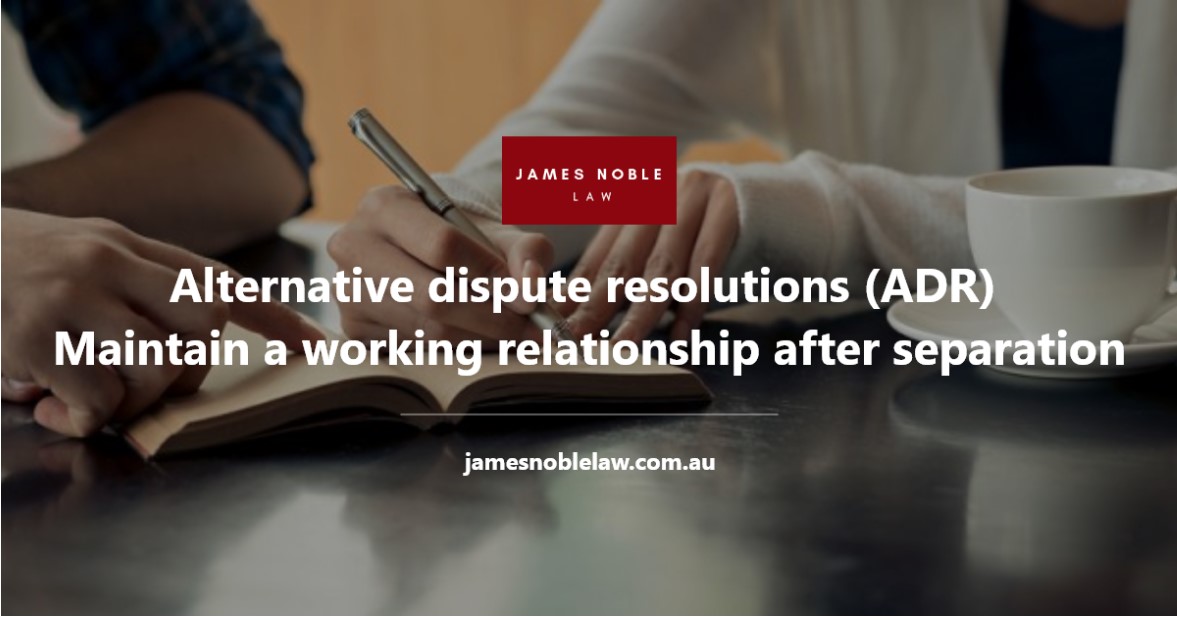
How to avoid court?
Alternative dispute resolution. Maintain a working relationship with your former partner after separation, especially if there are children
 For the sake of your family, especially your children, after a separation, it is important, if at all possible to do so, to maintain a working relationship with your former partner alternative dispute resolution. If only for a short period of time to help negotiate a resolution of financial and children’s issues. Seek a resolution of such issues that best suits your children, yourself, and your former partner.
For the sake of your family, especially your children, after a separation, it is important, if at all possible to do so, to maintain a working relationship with your former partner alternative dispute resolution. If only for a short period of time to help negotiate a resolution of financial and children’s issues. Seek a resolution of such issues that best suits your children, yourself, and your former partner.
Importantly, try and avoid the emotional and financial stress of litigating these matters in the Family Court.
If you require assistance to resolve such issues, there are many forms of alternative dispute resolution that DO NOT involve Court proceedings.
Of the following celebrities, which ones used litigation to resolve their disputes, and which ones used alternative dispute resolution? Which ones were involved in vitriolic public slinging matches portrayed in the media worldwide which provided detailed information about their relationship.? Madonna, Uma Thurman, Robin Williams, Tiger Woods, Paul McCartney, and Ashley Cole.
Madonna, Uma Thurman, and Robin Williams used alternative dispute resolution processes with very little, if any, information being provided publicly to the world. We all know about the public breakdown of the relationships between Paul McCartney and Heather Williams, Tiger Woods, and Ashley Cole who went down the litigation path.
The lesson to be learned is that at all costs try to avoid a litigated resolution.
There are numerous studies showing the substantial harm which can be inflicted on children in high conflict divorces when parents use the Courts as a means of addressing deep emotional pains that they have suffered as a result of their separation. The Courts do not have the power to remedy such emotional issues. The Courts, even with the best intentions, are not equipped to deal with the emotional issues resulting from a relationship breakdown.
The Court’s function is based on an adversarial model. The Courts can only provide limited financial and psychological services that are required and which result from a relationship breakdown.
Most litigants emerge from Family Court proceedings disillusioned with the Court process. Unhappy clients are commonplace in family law litigation. They are more likely to receive a decision that falls far short of a resolution which they had hoped for.
Most matters in the Family Court are resolved prior to the decision being made by the judge. At some stage during the Family Court process, a resolution is achieved. Only 4% of matters proceed to Court for a judge to make a decision. 75% of such matters relating to children’s issues.
Emotional and financial costs, which in most cases are irreversible, are often incurred in the lengthy preparation of the matter for a trial that precedes the eventual effort to settle. In many cases, agreements are hammered out virtually on the eve of the trial date through considerable pressure from lawyers and in some cases judges.
Is there an alternative dispute resolution?
Many alternative dispute resolution processes are available. Alternative dispute resolution is available to help parties resolve the relationship issues if they are unable to do so by themselves.
Collaborative practice for Alternative dispute resolution
Collaborative Practice has now established itself as a prominent means of resolving family law issues in Australia. Collaborative practitioners are governed by the International Academy of Collaborative Professionals (IACP). Members include family law practitioners, psychologists, consultants, financial planners and accountants, financial consultants, and communication professionals.
The main distinguishing element of Collaborative Practice from other areas of family law practice is the binding collaborative agreement referred to as the ‘participation agreement’. Pursuant to the terms of this agreement, the collaborative professionals and their clients are prohibited from participating in contested court proceedings during the period of the collaborative negotiations.
In Collaborative Practice, the desires and wishes of the parties participating in the negotiations are ascertained prior to the first combined meeting with their lawyers in the early stages of the joint negotiation meetings. It is quite common for parties to have the same wishes and goals, which are usually recorded on a whiteboard and which are visible throughout the negotiating process. The wishes and goals normally are:
- A wish to reach a fair agreement with the other party;
- A wish to agree to a settlement that will provide financial security not only for myself but for the family;
- Not to involve the children in our conflict;
- A desire to do what is best for the children and the family;
- A wish to maintain as best as possible a friendship with the former partner, which will assist us to effectively co-parent the children in the future, and to be involved in the future lives of our children, such as attending on family occasions, weddings and to maintain a strong relationship with the grandchildren;
- A desire for both parties to maintain our association with our mutual friends and extended families;
- A wish to maintain the privacy of our affairs and for details of the problems we are facing from being aired publicly or becoming the subject of a public Court record;
- A wish not to have some other people such as a judge make a decision for us and to manage and restructure our financial affairs or to determine future arrangements we will have with our children.
Collaborative professionals and family lawyers have extensive training and continuous training to work together to reach an agreement that is fair and reasonable to all concerned. Collaborative professionals are trained to listen deeply to their client’s entire story on their first meeting with their clients prior to any negotiations taking place to gain a clear understanding of the wishes, goals, and emotional issues that are involved in their client’s life. The client in the first meeting will receive an education about the negotiating process involved in collaborative practice, which will empower the client to participate actively and effectively in the negotiations that will take place in the later joint meetings. Collaborative professionals assist their clients to achieve their highest intentions for themselves and their children in the post-divorce restricted family environment. Collaborative lawyers have an effective working relationship with each other. They work on a common basis to achieve the best results for their clients. Collaborative practice provides creative problem-solving that is not available or exists in mediation or litigation. The collaborative lawyers work together to assist the clients to reach a resolution that best meets the needs of the clients.
All discussions, information sharing, option development, and negotiation take place in face-to-face meetings with the clients. The role of the collaborative professionals is to facilitate the negotiations and in the management of conflict. Collaborative professionals work effectively with their clients to offer the best possible circumstances in which to carry out negotiations in good faith in an interest-based respectful manner, to reach a mutually beneficial and accepted outcome.
Family consultants and financial consultants can be involved in collaborative negotiations.
The family consultants maintain a highly focused communication process during the negotiation process. They endeavor to reduce the stress levels during the meetings and assist the parties to clarify the issues involved. The family consultants have been trained in anger management skills which help the parties move as effectively as possible through the process. They provide balanced, non-judgemental, non-evaluative information about the children’s needs, with the aim of developing parenting plans for the children. They have a very comprehensive role in assisting the parties in reaching a resolution.
The financial consultant assists the parties to clearly identify their property and financial issues, incomes, and expenses, and effectively document such matters for the collaborative lawyers to use in the negotiation process. They can assist the parties with any budgeting concerns. They assist in identifying the financial issues that need to be addressed. They assist in the settlement process by analyzing taxation issues and in projecting long term financial consequences of various settlement options that may be put forward during the negotiation process.
The team approach of lawyers and consultants significantly reduces the costs of conducting the negotiations. The team approach streamlines negotiations and provides long-lasting ‘value-added’ resolutions. It enables the parties to negotiate educated resolutions of the issues involved.
James Noble give a Brief on Australian Collaborative Law
The team approach enables the parties to reach respectful, efficient, lasting, mutually workable solutions to financial and parenting issues. It assists the parties as parents to provide effective co-parenting of their children in the future.
Mediation
Overview of Mediation
 Mediation is a voluntary process, but the Family Court may order that you and your former partner participate in mediation, depending on your circumstances. Only you, your former partner and your lawyers, and the Mediator will be part of the Mediation process.
Mediation is a voluntary process, but the Family Court may order that you and your former partner participate in mediation, depending on your circumstances. Only you, your former partner and your lawyers, and the Mediator will be part of the Mediation process.
Depending on the level of conflict and personal dynamics of the relationship between you and your former partner two Mediators may be necessary.
The Mediator’s role is to assist communication between you and your former partner so that you can have open discussions and negotiate a settlement.
Role of the Mediator
The Mediator’s aim is to facilitate open communication between you and your partner so that you can:
- Identify issues of the dispute
- Generate options to address these issues
- Agree upon ways to resolve the issues (i.e. ‘settlement’)
The Mediator’s role is essentially a neutral one. The Mediator:
- Will not take sides
- I Will work with both you and your former partner to help you negotiate your own decisions together
- Will not represent either of you in Court either before or after the Mediation
Characteristics of Mediation
- All decisions in mediation will be made by you and your former partner, not the Court or anyone else
- The mediation will help you to identify important issues that relate to your assets and finances and/or care arrangements for your children
- Mediation is readily accessible, making it fast and efficient
- Mediation is a popular form of alternative dispute resolution
Fact-finding and isolation of issues
At this stage the Mediator will obtain as much relevant information as possible, identifying the issues to be discussed and identifying any underlying conflict which may be associated with such issues. The issues will deal with such matters as property, financial assistance, and children.
Once the issues have been identified, the Mediator will then establish an agenda setting out the order in which the issues should be dealt with and the most appropriate way of dealing with such issues.
Creation of options and alternatives
At this point, you and your partner will be looking at all the options and alternatives which could apply and which could be of assistance in resolving the issues which have been identified. By dealing with the options and alternatives, you will determine the most effective way of dealing with each issue. At this time, the Mediator will encourage you to be as creative as possible in setting up these options and alternatives.
Negotiation and decision-making at this point, you will be:
- Choosing options which you can best live with
- Ensuring that you fully understand the details and implications of each proposal and what their consequences will be for you
As you could imagine there will be a lot of discussion at this point in reaching an agreement on those options and alternatives.
Clarification of agreements reached
Hopefully, agreements will be reached on issues that have been isolated and discussed, and the Mediator will then prepare a written draft setting out your concerns, intentions, the facts agreed, and decisions that have been reached. The agreement can also deal with your future dealings and your relationship with your former partner.
Review of Process
At this point, you can look at the matters that need to be made legally binding and determine the future review procedures required if any.
Implementation stage
The agreement is made legally binding and the terms carried out.
Overview of Collaborative Practice and Mediation
 Collaborative Practice and Mediation are both good alternatives to litigation when resolving disputes. Each of these methods has its own strengths, depending on the circumstances of the issue or dispute to be resolved. Your lawyer will assist you to assess whether either the Collaborative Practice or Mediation approaches are right for you.
Collaborative Practice and Mediation are both good alternatives to litigation when resolving disputes. Each of these methods has its own strengths, depending on the circumstances of the issue or dispute to be resolved. Your lawyer will assist you to assess whether either the Collaborative Practice or Mediation approaches are right for you.
Deciding what’s most important to you
Some people pursue litigation because they want to ‘win at all costs’, or for whatever reason the matter cannot resolve by negotiation or another process.
Major disadvantages of Litigation
By taking your matter to Court, you are likely to experience:
- High monetary costs and high levels of emotional and physical stress
- Long delays
- The need to sell assets at an ill-opportune time; prolonged and bitter conflict over the division of assets and finances
- Uncertain results, because a Court decision will be imposed on you by the Judge and you will have no say in the outcome of your case
The efficiency of Collaborative Practice and Mediation
Dispute resolution via Collaborative Practice or Mediation can be arranged in a timely manner and satisfactory outcomes can be reached relatively quickly. Collaborative Practice negotiations usually take place either over a number of two-hour sessions or in one session in mediation.
Costs associated with Collaborative Practice and Mediation
- Initial consultation with your lawyer
- The assistance of the lawyer to complete a short history statement, if necessary
- The assistance of the lawyer to provide full disclosure of documents, if necessary
- Attendance by the lawyer in the Collaborative Practice meetings and in the mediation session
- Preparation of consent documents by the lawyers
- Involvement of the lawyer throughout the entire Collaborative Practice and mediation process
Other information relating to costs of Collaborative Practice and Mediation
- Discussions in the first Collaborative meeting and agreement on the payment of the fees
- The fees may be a shared arrangement
- The costs of the Mediator will be agreed upon prior to the commencement of the process
- Because of the short duration for the preparation for attending on and completion of the Collaborative Practice and Mediation costs are limited
Because Collaborative Practice and Mediation resolve matters speedily and amicably, the financial and emotional damage normally caused by Litigation will be avoided by you, your family, and your friends.
Collaborative Practice will minimize conflict between you and your former partner. It will form a basis for your ongoing relationship with your former partner.
Need help?
If you need help, please contact the Brisbane Family lawyers team at James Noble Law today for a FREE, no-obligation 20-minute consultation. To schedule an appointment with one of our Qualified and experienced Family lawyers Brisbane.

You may also like to know more information about the
- Learn about Family court portal.
- Learn about Brisbane court house.
- Spousal maintenance qld, Brisbane, Australia.
- Online Divorce application In Australia.
- Divorce property settlement examples Australia.
- Family Law act 1975.
- Parental Responsibilities and Legislation.
- Mother withholding child from father Australia.


